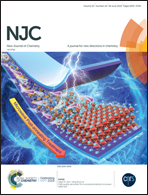Enhancement of CO2 capture and separation of CO2/N2 using post-synthetic modified MIL-100(Fe)†
Abstract
Iron metal–organic framework, MIL-100(Fe) was prepared by a hydrothermal method and used as a support to incorporate diethylenetriamine (DETA) for the study of CO2 adsorption and separation of CO2/N2. All synthesized adsorbents were characterized by PXRD, N2 adsorption–desorption isotherms, FT-IR, TGA, SEM, and elemental analysis. Structural characterization results have revealed that the structure of MIL-100(Fe) was not changed by the incorporation of diethylenetriamine. The CO2 adsorption capacities were 29 cm3 g−1 and 41 cm3 g−1 at 298 K, 1 bar for MIL-100(Fe) and DETA–MIL-100(Fe), respectively. Adsorption of CO2 on DETA–MIL-100(Fe) was higher than that on MIL-100(Fe). The enhancement was due to the presence of amine groups which could form ammonium carbamate by interaction with CO2. Similarly, the N2 adsorption capacities were 3 cm3 g−1 and 0.9 cm3 g−1 at 298 K, 1 bar for MIL-100(Fe) and DETA–MIL-100(Fe), respectively. The decrease in N2 adsorption capacity was due to the decrease in surface area. The selectivity of CO2/N2 on DETA–MIL-100(Fe) was four times higher than that on MIL-100(Fe). The heat of CO2 adsorption was 74.2 kJ mol−1 at low coverage of CO2 on DETA–MIL-100(Fe) and the CO2 adsorption capacity was constant in each adsorption cycle over the same adsorbent.



 Please wait while we load your content...
Please wait while we load your content...